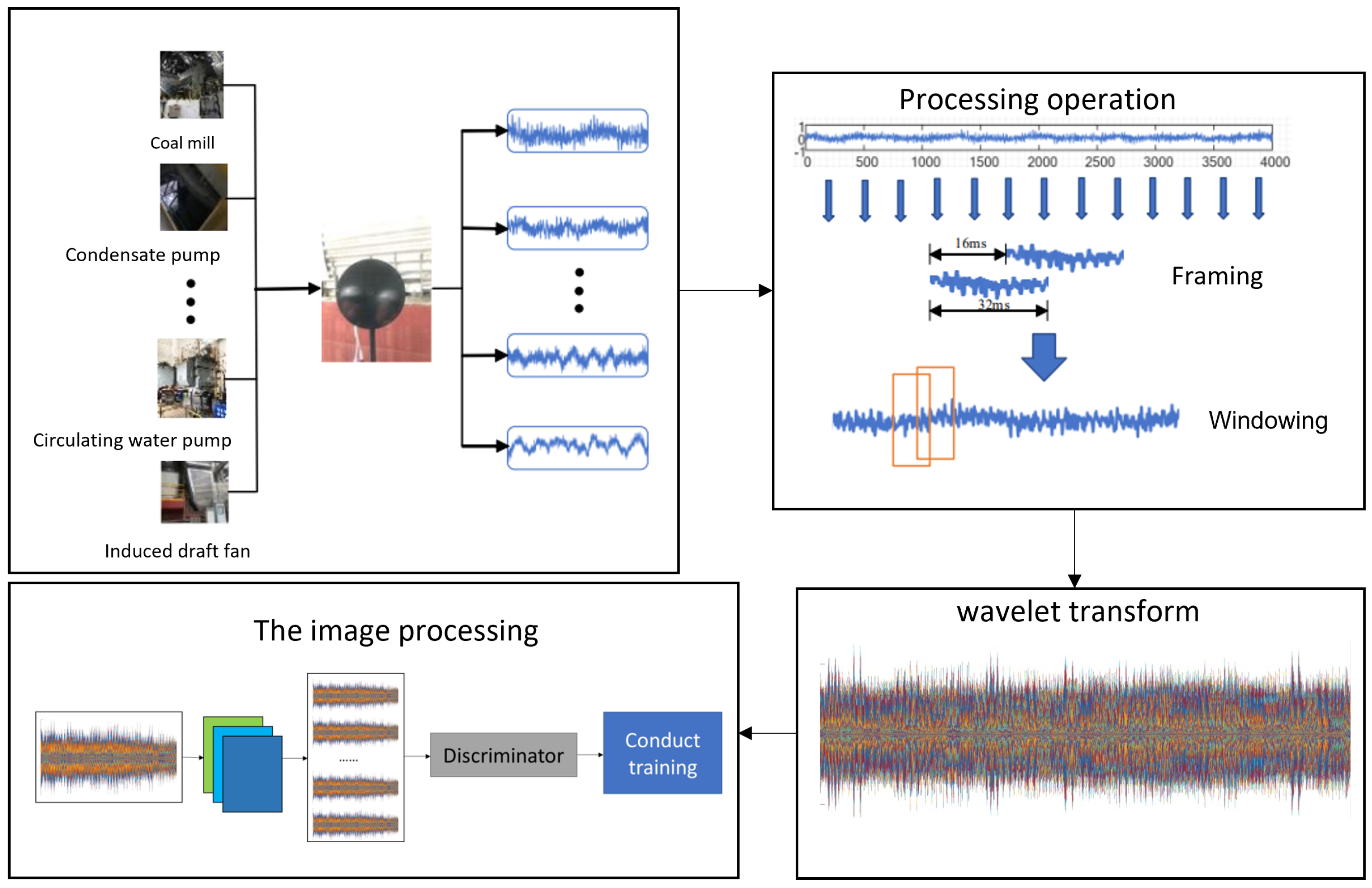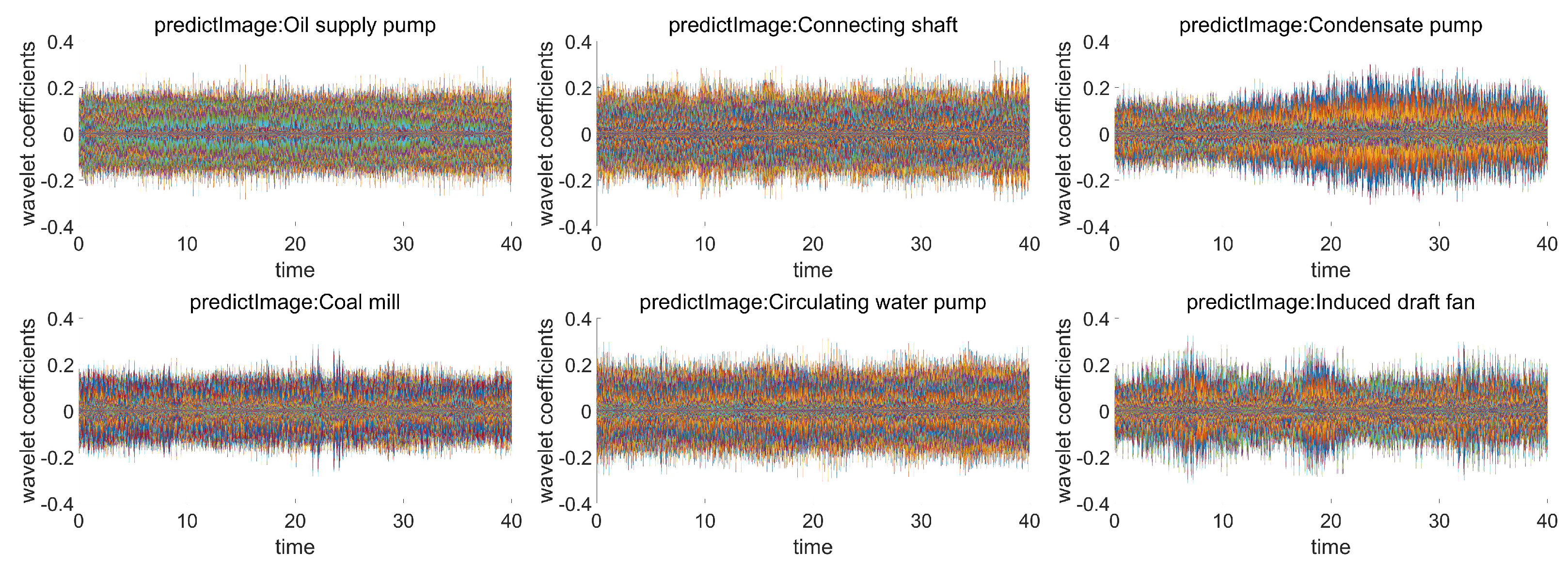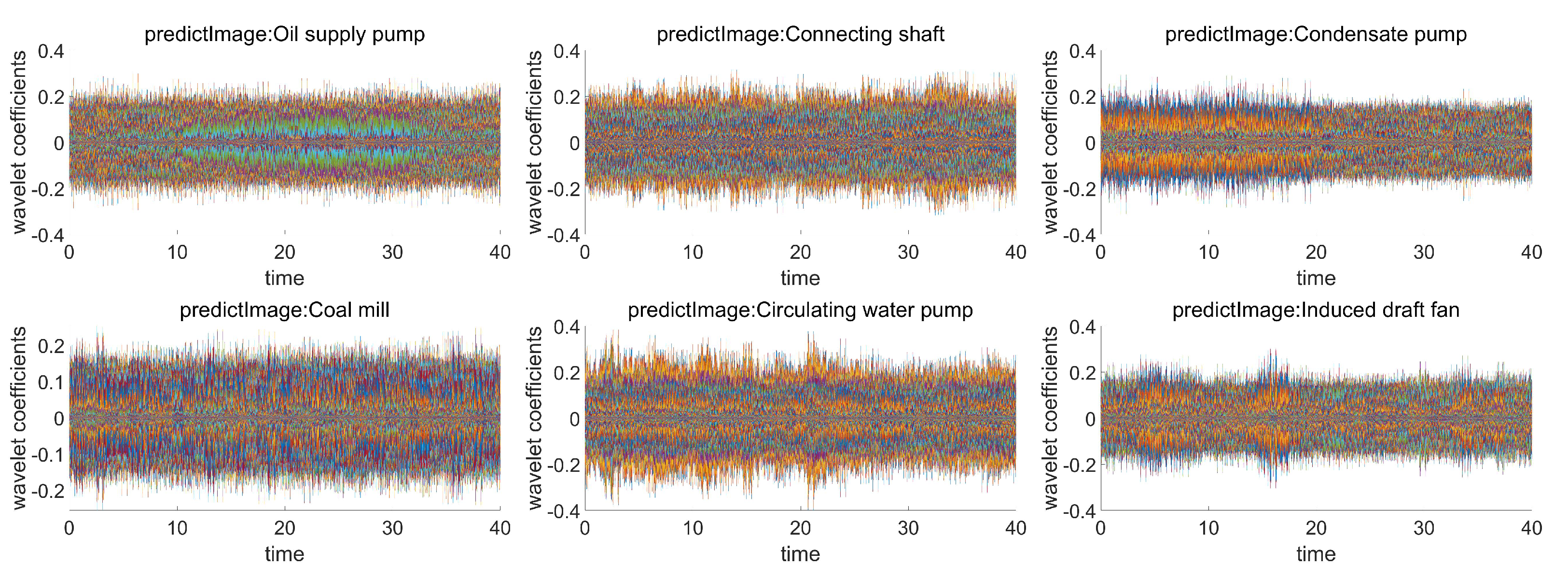HOG-SVM-Based Image Feature Classification Method for Sound Recognition of Power Equipments
Abstract
:1. Introduction
2. Audio Signal Analysis Based on Wavelet Transform
- Preprocessing: the digital strainer is used to preemphasize the audio signal, determine the frame length and frame shift of each sound signal, and the Hamming window is used to filter the sound signal by framing and windowing to obtain multi-frame sound signals;
- Wavelet analysis: by obtaining separate sound signal samples of power equipment through preprocessing operation, we can analyze the characteristics of the sound signal, select an appropriate wavelet function to carry out wavelet transform on the sound signal, and obtain the time wavelet coefficient diagram of each audio signal sample;
- Image processing: considering that the wavelet coefficient image obtained in the above steps contains a large number of image features, this study first uses SSIM (Structural Similarity) image processing method to calculate the similarity between wavelet coefficient images of sound signals of different devices and the same device, so as to verify the feasibility of image classification.
- HOG + SVM: extract the hog feature of the obtained wavelet coefficient image, and substitute the extracted feature into the SVM classifier for multi-classification training, so as to achieve the purpose of classification and prediction of the existing image.
2.1. Sound Signal Preprocessing
- Slice. In order to unify the duration of the sound sample, the sound signal of the whole section of audio is segmented into 1 s as a sound sample;
- Pre-emphasis. In order to flatten the spectrum of the sound signal, the spectrum can be calculated with the same structural return loss in the low-frequency to high-frequency band, and the sound signal of each sample is pre-emphasized. Pre-emphasis processing means that the sound signal passes through a high clear strainer:where in 0.9 < < 1.0, is taken as 0.97 in this paper.
- Normalization. Normalize the spectrum of the preprocessed sound signal to reduce the difference in the frequency range of different types of sound:
- Framing and windowing. The sound signal is stable in a short time. The short-time length is generally 10–30 ms. In order to facilitate feature analysis, the sound signal needs to be processed in frames. For purpose of ensuring the smooth conversion between two adjacent frames, the frame signal needs to be superimposed, and then each frame is multiplied by a window function of a certain length for windowing and filtering. In this paper, Hamming window is adopted, and the window function is shown in Formula (3):
2.2. Feature Extraction of Audio Signal Based on Wavelet Transform
2.2.1. Definition of Wavelet Function
2.2.2. Wavelet Sequence
2.3. SSIM-Based Image Processing Method
2.3.1. Definition
2.3.2. Application of SSIM
2.4. HOG Feature Extraction Algorithm
Feature Extraction Process
- Window: divide the image into multiple identical windows according to a certain size and slide;
- Block: divide each window into several same blocks according to a certain size and slide;
- Cell: each window is divided into multiple identical cells according to a certain size, which belong to the feature extraction unit and remain stationary.
2.5. Support Vector Machines (SVM)
3. Experimental Result
4. Conclusions
Author Contributions
Funding
Institutional Review Board Statement
Informed Consent Statement
Data Availability Statement
Conflicts of Interest
References
- Liang, L.; Liu, S.; Li, Y.; Zhong, M.; Li, Y. Distributed fault detection and isolation for power system. Int. J. Robust Nonlinear Control 2021, 32, 2143–2158. [Google Scholar] [CrossRef]
- Bakhtadze, N.; Yadikin, I. Analysis and Prediction of Electric Power System’s Stability Based on Virtual State Estimators. Mathematics 2021, 9, 3194. [Google Scholar] [CrossRef]
- Peng, J.; Yang, P.; Liu, Z.; Sun, G. Double-Fed Wind Power System Adaptive Sensing Control and Condition Monitoring. J. Sens. 2021, 2021, 5753947. [Google Scholar] [CrossRef]
- Liu, R.; Yang, B.; Zio, E.; Chen, X. Artificial intelligence for fault diagnosis of rotating machinery: A review. Mech. Syst. Signal Process. 2018, 108, 33–47. [Google Scholar] [CrossRef]
- Yang, Z.; Diao, C.; Li, B. A Robust Hybrid Deep Learning Model for Spatiotemporal Image Fusion. Remote Sens. 2021, 13, 5005. [Google Scholar] [CrossRef]
- Cao, P.; Zhang, S.; Tang, J. Preprocessing-Free Gear Fault Diagnosis Using Small Datasets With Deep Convolutional Neural Network-Based Transfer Learning. IEEE Access 2018, 6, 26241–26253. [Google Scholar] [CrossRef]
- Kafeel, A.; Aziz, S.; Awais, M.; Khan, M.A.; Afaq, K.; Idris, S.A.; Mostafa, S.M. An Expert System for Rotating Machine Fault Detection Using Vibration Signal Analysis. Sensors 2021, 21, 7587. [Google Scholar] [CrossRef]
- Ribeiro, L.C.; Bonaldi, E.L.; de Oliveira, L.E.L.; da Silva, L.E.B.; Salomon, C.P.; Santana, W.C.; Silva, J.G.B.; Lambert-Torres, G. Equipment for Predictive Maintenance in Hydrogenerators. AASRI Procedia 2014, 7, 75–80. [Google Scholar] [CrossRef]
- Song, Z.; Zhang, Z.; Jiang, Y.; Zhu, J. Wind turbine health state monitoring based on a Bayesian data-driven approach. Renew. Energy 2018, 125, 172–181. [Google Scholar] [CrossRef]
- Li, Q.; Hu, W.; Peng, E.; Liang, S.Y. Multichannel Signals Reconstruction Based on Tunable Q-Factor Wavelet Transform-Morphological Component Analysis and Sparse Bayesian Iteration for Rotating Machines. Entropy 2018, 20, 263. [Google Scholar] [CrossRef] [Green Version]
- Yu, J.; Bai, M.; Wang, G.; Shi, X. Fault diagnosis of planetary gearbox with incomplete information using assignment reduction and flexible naive Bayesian classifier. J. Mech. Sci. Technol. 2018, 32, 37–47. [Google Scholar] [CrossRef]
- Herp, J.; Ramezani, M.H.; Bach-Andersen, M.; Pedersen, N.L.; Nadimi, E.S. Bayesian state prediction of wind turbine bearing failure. Renew. Energy 2018, 116, 164–172. [Google Scholar] [CrossRef] [Green Version]
- Wang, D. An extension of the infograms to novel Bayesian inference for bearing fault feature identification. Mech. Syst. Signal Process. 2016, 80, 19–30. [Google Scholar] [CrossRef]
- Li, K.; Zhang, Q.; Wang, K.; Chen, P.; Wang, H. Intelligent Condition Diagnosis Method Based on Adaptive Statistic Test Filter and Diagnostic Bayesian Network. Sensors 2016, 16, 76. [Google Scholar] [CrossRef] [Green Version]
- Yu, J.; Ding, B.; He, Y. Rolling bearing fault diagnosis based on mean multigranulation decision-theoretic rough set and non-naive Bayesian classifier. J. Mech. Sci. Technol. 2018, 32, 5201–5211. [Google Scholar] [CrossRef]
- Li, X.; Makis, V.; Zuo, H.; Cai, J. Optimal Bayesian control policy for gear shaft fault detection using hidden semi-Markov model. Comput. Ind. Eng. 2018, 119, 21–35. [Google Scholar] [CrossRef]
- Liu, J.; Hu, Y.; Wu, B.; Wang, Y.; Xie, F.; Wang, X. A Hybrid Generalized Hidden Markov Model-Based Condition Monitoring Approach for Rolling Bearings. Sensors 2017, 17, 1143. [Google Scholar] [CrossRef] [PubMed]
- Gan, H.; Jiao, B. Fault Diagnosis of Wind Turbine’s Gearbox Based on Improved GA Random Forest Classifier. DEStech Trans. Eng. Technol. Res. 2018, 206–210. [Google Scholar] [CrossRef]
- Li, C.; Sanchez, R.V.; Zurita, G.; Cerrada, M.; Cabrera, D.; Vásquez, R.E. Gearbox fault diagnosis based on deep random forest fusion of acoustic and vibratory signals. Mech. Syst. Signal Process. 2016, 76, 283–293. [Google Scholar] [CrossRef]
- Han, T.; Jiang, D. Rolling Bearing Fault Diagnostic Method Based on VMD-AR Model and Random Forest Classifier. Shock Vib. 2016, 2016, 5132046. [Google Scholar]
- Qin, X.; Li, Q.; Dong, X.; Lv, S. The Fault Diagnosis of Rolling Bearing Based on Ensemble Empirical Mode Decomposition and Random Forest. Shock Vib. 2017, 2017, 2623081. [Google Scholar] [CrossRef]
- Verellen, T.; Verbelen, F.; Stockman, K.; Steckel, J. Beamforming Applied to Ultrasound Analysis in Detection of Bearing Defects. Sensors 2021, 21, 6803. [Google Scholar] [CrossRef] [PubMed]
- Śmieja, M.; Mamala, J.; Prażnowski, K.; Ciepliński, T.; Szumilas, Ł. Motion Magnification of Vibration Image in Estimation of Technical Object Condition-Review. Sensors 2021, 21, 6572. [Google Scholar] [CrossRef]
- Cao, H.; Yu, J.; Wang, Y.; Zhang, L.; Kim, J. A Fault Diagnosis System for a Pipeline Robot Based on Sound Signal Recognition. Sensors 2022, 22, 3275. [Google Scholar] [CrossRef] [PubMed]
- Suman, A.; Kumar, C.; Suman, P. Early detection of mechanical malfunctions in vehicles using sound signal processing. Appl. Acoust. 2022, 188, 108578. [Google Scholar] [CrossRef]
- Kumar, R.; Gupta, M.; Ahmed, S.; Alhumam, A.; Aggarwal, T. Intelligent Audio Signal Processing for Detecting Rainforest Species Using Deep Learning. Intell. Autom. Soft Comput. 2022, 31, 693–706. [Google Scholar] [CrossRef]
- Zhuo, D.; Cao, H. Damage identification of bolt connection in steel truss structures by using sound signals. Struct. Health Monit. 2022, 21, 501–517. [Google Scholar] [CrossRef]
- Birch, B.; Griffiths, C.A.; Morgan, A. Environmental effects on reliability and accuracy of MFCC based voice recognition for industrial human-robot-interaction. Proc. Inst. Mech. Eng. Part J. Eng. Manuf. 2021, 235, 1939–1948. [Google Scholar] [CrossRef]
- Liu, C.L.; Qi, W.X. Research on Fault Diagnosis Method of Wind Turbine Based on Wavelet Analysis and LS-SVM. Adv. Mater. Res. 2013, 2479, 724–725. [Google Scholar] [CrossRef]
- Li, D.S.; Zhou, Z.Q.; Zhang, C.; Du, P.; Hu, Y.R. Sound Recognition Algorithm for Power Devices Based on Substation Inspection Robots. Appl. Mech. Mater. 2014, 3360, 1139–1144. [Google Scholar] [CrossRef]





| Sample Type | Number of Samples | Total Number of Samples |
|---|---|---|
| Oil supply pump | 200 | 1200 |
| Connecting shaft | 200 | |
| Condensate pump | 200 | |
| Coal mill | 200 | |
| Induced draft fan | 200 | |
| Circulating water pump | 200 |
| Sample Type | Single Class Accuracy | Overall Accuracy |
|---|---|---|
| Oil supply pump | 80% | 90% |
| Connecting shaft | 100% | |
| Condensate pump | 100% | |
| Coal mill | 80% | |
| Induced draft fan | 100% | |
| Circulating water pump | 80% |
| Sample Type | Single Class Accuracy | Overall Accuracy |
|---|---|---|
| Oil supply pump | 80% | 87% |
| Connecting shaft | 100% | |
| Condensate pump | 100% | |
| Coal mill | 60% | |
| Induced draft fan | 100% | |
| Circulating water pump | 80% |
Publisher’s Note: MDPI stays neutral with regard to jurisdictional claims in published maps and institutional affiliations. |
© 2022 by the authors. Licensee MDPI, Basel, Switzerland. This article is an open access article distributed under the terms and conditions of the Creative Commons Attribution (CC BY) license (https://creativecommons.org/licenses/by/4.0/).
Share and Cite
Bai, K.; Zhou, Y.; Cui, Z.; Bao, W.; Zhang, N.; Zhai, Y. HOG-SVM-Based Image Feature Classification Method for Sound Recognition of Power Equipments. Energies 2022, 15, 4449. https://doi.org/10.3390/en15124449
Bai K, Zhou Y, Cui Z, Bao W, Zhang N, Zhai Y. HOG-SVM-Based Image Feature Classification Method for Sound Recognition of Power Equipments. Energies. 2022; 15(12):4449. https://doi.org/10.3390/en15124449
Chicago/Turabian StyleBai, Kang, Yong Zhou, Zhibo Cui, Weiwei Bao, Nan Zhang, and Yongjie Zhai. 2022. "HOG-SVM-Based Image Feature Classification Method for Sound Recognition of Power Equipments" Energies 15, no. 12: 4449. https://doi.org/10.3390/en15124449






